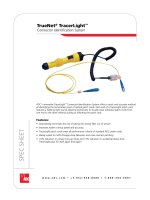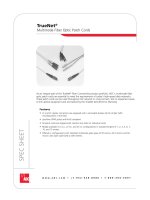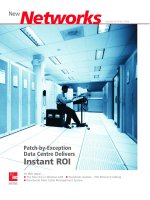Tài liệu ADC Backhaul Solutions pdf
Bạn đang xem bản rút gọn của tài liệu. Xem và tải ngay bản đầy đủ của tài liệu tại đây (882.09 KB, 8 trang )
WHITE PAPER
ADC Backhaul Solutions
Breaking the Wireless Backhaul Bottleneck
Breaking the Wireless Backhaul Bottleneck with
ADC Backhaul Solutions
Executive Summary
Continued cellular market penetration, burgeoning consumer demand for
wireless rich media, and the promise of even more data-intensive applications
continue to drive bandwidth consumption, fueling an estimated 100 percent
increase in the global number of cellular base stations by 2009. 3G and 4G
cellular services, which require very low latency and packet-based switching,
place additional burdens on existing infrastructure, taxing copper backhaul
solutions to their limits. As a result, the cost of leased lines, which currently
accounts for approximately 15 percent or more of operational expenditures
(OPEX), will increasingly burden service providers who continue to expand
aging architecture to meet their expanding backhaul needs.
To address these increasing demands and cost pressures, wireless carriers need
to evaluate their existing assets, identify the ideal solutions to meet future needs,
and implement cost-effective technologies to migrate their existing architectures
to their ideal design over time. ADC, a world leader in providing global network
infrastructure products and services, offers a portfolio of backhaul solutions that
can assist mobile operators in meeting their wireless backhaul challenges.
Background
Increasing Need for Wireless Backhaul Solutions
Cellular subscription growth remains strong. Infonetics Research estimates that
global cellular subscriptions will reach 3 billion in 2009,
1
a one-half increase from
2005 levels (2 billion). This expanding subscriber base will continue to generate
a sharp, linear rise in cellular traffic, prompting service providers to construct
additional base stations. U.S. carriers are adding to the current domestic total
of 140,000 base stations by 6 percent annually, while foreign carriers ramp
up even faster. According to an article by Yankee Group’s Phil Marshall, the
global number of cellular base stations will double from 1.8 million in 2005,
to 3.6 million in 2009,
2
in large part due to a continuing upswing in cellular
subscriptions. Developing nations with very little existing backhaul architecture
in place will account for many of these installations.
An equally important driver of network consumption is the expansion of
cellular services beyond traditional voice and text messaging. Increasingly,
cellular offerings encompass a more full-featured blend of voice, data, video,
and other rich media. Industry observers expect continued growth in mobile
broadband access with users demanding the same types of content provided
by home broadband connections. Emerging 3G handsets will deliver similar
content to cell phones and PDAs. As mobile users become more accustomed
to accessing data-rich content via portable devices, and newer markets
(e.g., the U.S. and South America) roll out 3G services, carriers recognize
the need for substantially more bandwidth—and with more packet traffic
efficiency —than current infrastructures allow. In fact, wireless carriers
estimate that leased line backhaul costs will increase to greater than
25 percent of wireless carrier operational expenditure (OPEX) with the
rollout of new data services.
3
Any future migrations to 4G standards, with
the potential of 100 Mbits per mobile connection, will only further expand
the need for even greater backhaul capabilities.
Breaking the Wireless Backhaul Bottleneck with ADC Backhaul Solutions
Page 3
Costs of Traditional Backhaul Infrastructure
Typical North American backhaul solutions use
leased copper T1 and DS-3 lines. These Time Division
Multiplexed (TDM) access and transport solutions are
inefficient conduits for data-intensive applications, and
are becoming increasingly expensive to scale. Yankee
Group estimates that, with monthly charges of $400 to
$600 for each T1 line, leased lines currently account for
roughly 15 percent of OPEX.
One reason for this high scaling cost stems from the
TDM circuit’s inability to statistically multiplex and take
advantage of the peakedness of data traffic types that do
not require constant bit rate delivery. Since TDM facilities
assign equal priority to all types of traffic, whether
it consists of text messages, streaming video, or voice
calls, service providers must ensure adequate bandwidth
to handle peak backhaul demand at all times, rather
than simply delivering lower-priority data during
throughput lulls.
The most common form of cell site backhaul
internationally is TDM microwave. While the wireless
carrier may avoid the expensive lease line charges
by deploying their own microwave they are still left
with an inefficient TDM facility for transport of bursty
data applications.
To reduce backhaul OPEX to manageable levels and build
truly 3G- and 4G-compliant networks, mobile carriers can
choose from solution portfolios that include a range of
products, utilizing fiber transport solutions or emerging
RF wireless protocols such as millimeter wave or WiMAX.
As a first step, carriers should project near-term and
long-term bandwidth and class of service demands
based on business goals and market conditions. After
determining these targets, providers should audit and
catalog their existing resources, including any planned
decommissions. With a solid understanding of their
business direction and a firm grasp of their current
capabilities, carriers can then make educated technology
selections to meet their future needs cost effectively.
Professional services organizations with relevant
experience can often provide helpful evaluation
frameworks and cost-saving advice during the
planning stage. For example, by projecting a legacy
backhaul architecture’s rising percentage of OPEX over
time, carriers can find the point at which the capital
expenditure (CAPEX) of new higher bandwidth backhaul
solutions would begin to show a positive ROI.
In markets with existing copper or fiber infrastructures,
carriers may benefit by optimizing existing networks
as much as possible with new higher bandwidth
solutions. In these applications, products that intelligently
aggregate, deploy, and manage network backhaul traffic
can provide cost-effective alternatives to continued
purchase or lease of additional T1 TDM bandwidth.
For new installations (e.g., greenfield applications),
or areas where cable or fiber are either absent or
impractical, wireless technologies, such as WiMAX or
millimeter wave, offer economical yet efficient backhaul
solutions. With proper planning, wireless backhaul links
can provide reliable, high quality transport throughput
without the expense of installing new lines. Wireless
transmission also allows service providers to retain
end-to-end control of their data, without the risk or
uncertainty of leasing through a third party. Carriers
should also look to extend the efficiency of these
investments through cross-connectivity hardware that
intelligently routes traffic between devices and provides
performance and reliability statistics allowing carriers to
assess their hardware needs as proactively as possible.
Addressing Wireless Backhaul Challenges
Page 3
Breaking the Wireless Backhaul Bottleneck with ADC Backhaul Solutions
Page 4
The ADC Wireless Backhaul
Portfolio: Flexibility, Economy, and Scalability
Figure 1: Through efficient aggregation and transport of legacy TDM services and 2.5/3G data services, the LoopStar SONET platform
eliminates the need for dedicated, point-to-point leased connections to each cell site.
Radio
Cell Site
Cell Site
T o wer
Ethernet
TDM
Network
DS1
DS3
SONET
OC-3/12
Data
Network
Moble Switching
Telephone Office
SONET
OC-3/12
Radio
LoopStar 800
Cell Site
Cell Site
T o wer
Analog/Digital
3G
GPS/EDGE
LoopStar 800
SONET
OC-3/12
DS1s
4
LoopStar 800
LoopStar
®
SONET 800/810/1600/3600
The LoopStar Synchronous Optical Network (SONET)
multi-service transmission platform enables service
providers to easily and economically provide Ethernet and
TDM backhaul at bandwidths above current DS1 or DS3
speeds (OC3 through OC192). The platform optimizes
fiber infrastructures for backhaul transport, allowing
carriers to aggregate, deploy, and manage 2.5G/3G
services and legacy TDM services at a substantial cost
savings. One major carrier realized 30 percent first
cost savings by implementing LoopStar 800 and 1600
series units at a new MSC (Mobile Switching Center)
in the southeastern U.S. Because the LoopStar 800
family features compact form factors and low power
consumption, it occupies little real estate in already
crowded cell sites or remote cabinet environments. Easily
scalable, the LoopStar 800 family can be supplemented
by additional units over time as carriers need additional
backhaul capacity.
Solutions Overview
Serving customers in more than 130 countries worldwide,
ADC offers an industry-leading portfolio of network
infrastructure solutions and services to ensure a smooth
transition as carriers transform traditional TDM circuit
switched voice networks to competitive broadband, video
and IP networks and create the backhaul systems needed
to support these services effectively. By implementing
a comprehensive product plan, optimizing existing
backhaul traffic, and building out copper-free transport,
carriers can reduce their dependence on third parties
and build a reliable, expandable, cost-effective backhaul
solution designed for the future.
Breaking the Wireless Backhaul Bottleneck with ADC Backhaul Solutions
Page 5
LoopStar
®
700
Since a service provider’s biggest asset is its existing
network, it makes economic sense to optimize that
network to the extent practicable. The LoopStar 700
product family is a next generation Ethernet Acccess
and Transport Solution optimized for converged packet
access at the edge over any type of available facility. The
LoopStar 700 family provides T1/E1 circuit emulation
functionality that can operate with a mix of fiber, cable,
radio or NxT1 systems. Ethernet packet access for 3G/4G
cellular services can be easily and cost effectively added
over N T1/E1 copper facilities using MLPPP with
the LoopStar 714/718. Where fiber exists or access to
Ethernet leased lines or WIMAX facilities are available,
the LoopStar 780/722 can cost effectively provide
converged access for T1/E1 TDM via circuit emulation
and Ethernet over the same facility. The LoopStar 700
provides bandwidth efficiency to minimize transport costs
and Ethernet layer 2 quality of service functionality to
meet service providers’ requirements for class-of-service
SLA flexibility. The LoopStar 700 family enables wireless
carriers to migrate toward an all Ethernet/IP transport
network.
Mobile Switching Office
Cell Site 1
2G/2.5G BTS
MSC
RNC
3G BTS
100/100TX/GigE
100/100TX/GigE
100/100TX/GigE
Ethernet
TDM
(4) 10/100 or 100FX
LS 780
Ethernet
Backahaul
Cell Site 2
2G/2.5G BTS
3G BTS
LS 780
Cell Site 3-N
2G/2.5G BTS
3G BTS
LS 780
Figure 2: Illustrates cell site backhaul using the LoopStar 780 to provide T1 TDM and Ethernet packet access over the same
Ethernet transport facility.
The LoopStar SONET platform comes in four form
factors, each tailored to a specific infrastructure need.
For instance, the 800/810 series offers capabilities
for smaller applications, while the 1600 and 3600
series provide robust functionality for high density
applications or metro rings, such as the application
being implemented by Open Access, a metropolitan area
network provider in the Long Island and New York City
area. The company is utilizing LoopStar 1600 and 810
devices in a network overlay design for wireless backhaul.
Says Robert Mavretich, president and co-founder of Open
Access, “We selected ADC’s LoopStar platform for our
optical network because it is a cost-effective and scalable
TDM delivery solution that best fits…the needs of our
business customers.”
4









